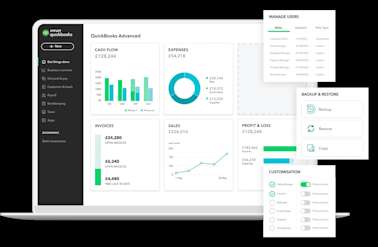
Cloud accounting
Accountant and bookkeeper product update - Your Books is now "Advanced"
Smart accounting software - no commitment, cancel anytime

FINANCE, BUDGETS AND CASHFLOW
As your business evolves, you’ll likely find yourself managing increasing numbers of invoices. Old manual workflows for invoice processing may not be as effective, and the stakes for making accurate payments on time may be higher. An efficient accounts payable department is vital for helping your business manage its cash flow efficiently.
But many employees find themselves caught up with piles of paper invoices and tedious manual data entry.
Lengthy approval workflows, manual data capture methods, and outdated accounting systems ultimately slow your business down.
Even if your business is small and you have just one employee managing invoicing, automation software can help streamline your business processes and save you time in the long run.
Invoice processing is the handling of invoices from arrival to archive, usually handled by the accounts payable team by using specific invoicing systems. The process handles the invoice lifecycle, right from receipt to approval or rejection then onto payment, and finally to archive.
It matches invoices to purchase orders and payment terms, ensuring that all vendor invoices are paid correctly and on time.
As your business scales up and the number of invoices you handle increases, you’ll need an efficient workflow for invoice processing. Otherwise, you may run the risk of not paying bills, incurring late fees, and annoying your suppliers.
When invoices are correctly processed, businesses can improve their cash flow by getting better payment terms, discounts, or more favourable pricing. For example, some suppliers offer early payment discounts to businesses.
Using an automation solution can help you go paperless and make your accounts payable process more efficient and accurate.
Sometimes known as procure-to-pay, the invoice process has several steps that start from when the invoice is received to the accounting system entry. Here are the five key steps for invoice processing:
First, collect your invoices and match your supporting documents, such as purchase orders and delivery receipts.
Enter invoice and payment details into your financial system.
Send invoices to your authorised approvers so they can either approve or reject the invoices. Submit authorised invoices to your financial system ready for payment.
Process invoice payments through common payment methods like Direct Debit, BACS, cheque or card payment. You can also accept payment through PayPal, Zettle and GoCardless.
Archive invoices and payment information in the general ledger (usually an ERP) for audit purposes.
These steps can be processed manually, but they’re time-consuming, prone to human error, and distract your team from other pressing tasks.
Automated invoice processing enables you to easily extract data from invoices entering your financial system. Instead of having to manually match up invoices with prices and purchase orders, the system will do it automatically and make changes in real time.
Also known as AP automation, it’s a system used to automate accounts payable invoicing processes. The most common automation systems capture invoice data by scanning and populating predetermined fields like supplier, purchase amount, and quantity
Once approved, the system then automatically carries out digital payments with credit cards, BACS, or other payment systems like PayPal.
Automated invoice processing speeds up your payments and helps ensure everyone is paid on time. Here are the top benefits:
Lowering the number of human touchpoints and enabling invoice software to take care of the legwork reduces the chance of human error. Automation should result in a reduction in duplicate invoice payments and invoice entry errors.
If you depend on manually processing invoices, it’s likely that at some point you’ll lose or misplace some key documents. You likely receive invoices in PDF formats, over email, or even in the mail, making it harder to track and enter all details correctly every time. Losing these documents is expensive, since you may be liable for late payment fees. Automating your process with an invoice software means everything is stored in one place from the moment it arrives.
Automating your invoice processing eliminates many manual tasks like data entry, routing, and validation. When employees no longer have to perform these repetitive tasks, they can use their time for more important activities.
QuickBooks invoicing software for small business enables you to make quick and secure payments, cutting out lengthy and complicated invoicing processes that are prone to human error. It reduces tedious admin tasks, freeing up your team to focus on achieving wider business goals.
Automated invoice software can save you both time and money. Find out how QuickBooks makes invoice processing easier for your business.
Never doubt your cash flow and how much you’re owed ever again––check at a glance which invoices have been paid in part or in full. You can also create and send invoices on the go, send automatic reminders, and allow customers to pay via the “pay” button on your invoice. Ready to streamline your invoice processing? Sign up for QuickBooks today.
We hope you’ve found this article on invoice automation useful. Invoice processing can be complicated and time-consuming: make this process easier by using QuickBooks accounting software.
9.00am - 5.30pm Monday - Thursday
9.00am - 4.30pm Friday